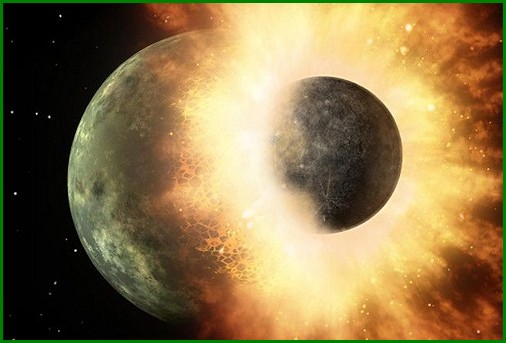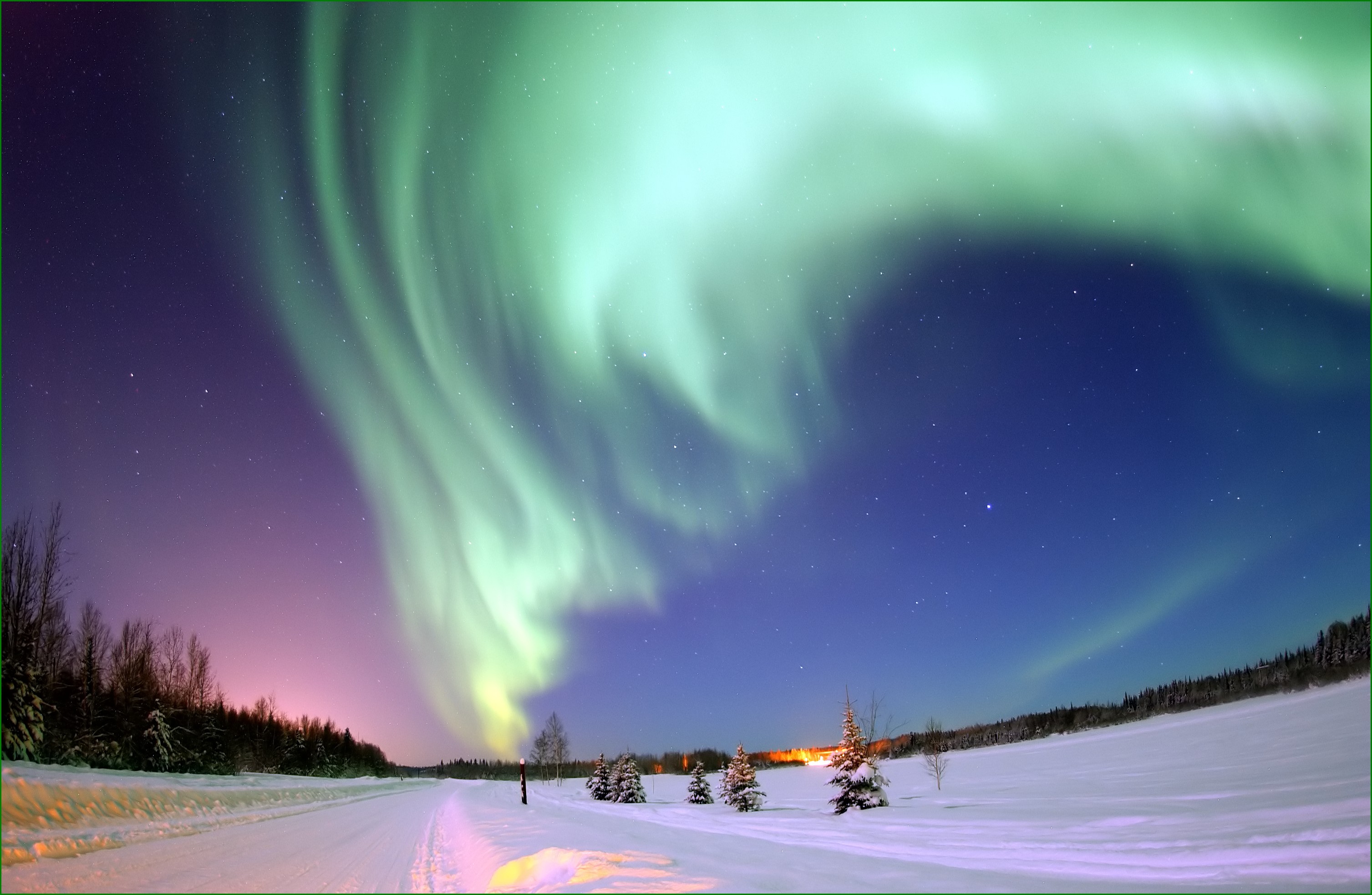Earth is losing its atmosphere than once Thanks to the recent updated analysis of the timing of the melting of lunar material revealed that the formation of the satellite age does not match with the age of the Earth's formation: unknown planet crashed into our ball after his appearance and knocked him out of a significant amount of matter that has gone on the construction of the moon.
Perhaps that's the way it was. (Image NASA / JPL-Caltech.).
...From which it follows that the Earth was at the moment of impact the dense atmosphere. And any account of this event shows that this atmosphere she had to lose.
So, even without knowing the data on the dating of the collision of Earth with a mysterious Teyey, planetary scientist Sara Stewart (Sarah Stewart) from Harvard University (USA) and his colleagues developed a model in which such an event leads to a loss of the atmosphere of our planet. Their model results scientists presented at a conference on the origin of the Moon. The event was held in London (United Kingdom) at the end of September.
In his research scientists with a special predilection traced the fate of helium and neon - gas spread throughout the solar system and is now almost absent from the Earth. And if the shortage of helium can be explained by its ease and the departure of outer space, the ease with neon, however.
After analyzing samples from the current Iceland, taken from the bottom of the Mid-Atlantic Ridge, Professor Stewart Co. found that the lower layers of the planet traces of helium and neon still there, and quite abundant. That is a few billion years ago, the two gases in the world were. But where did it all today? Why planet left relatively heavy neon?
For such a dramatic change is not enough to remove the cover from the banks, not being in a catastrophic event, the type of the giant impact, you have to throw at one time once the whole atmosphere, - says Ms. Stewart.
Here are just calculations show that even a very strong impact, such as interplanetary collision of Earth - Theia itself is not in a position to ensure that the ratio of neon in the lower and upper layers of the planet, which is observed in practice. Conclusion: The land was losing its atmosphere, not once, but several. Through a series of clashes in the ocean surface became molten lava, soon freezes, and then becomes liquid again.
Conflict of Earth - Theia likely was the last and most significant of these events, in addition to finishing off the original gaseous envelope of the planet and created more out of her large satellite debris.
All that's great, you say, but what are we breathe here? Indeed, if the atmosphere once was lost, its present existence is self-explanatory. The researcher believes that the atmosphere of our new second generation is largely responsible planetesimals, which continued to plummet to Earth after her clinch with Teyey.
However, this theory does not take into account recent studies presented at the same conference, and showing that the collision, which gave birth to the moon, did not happen 4.5 billion years ago, shortly after the formation of the planets, and to 100-200 million years later. In light of these figures fall to Earth planetesimals appears difficult to explain, for a couple of hundred million years after the planet in the solar system planetesimals are not supposed to be.
In any case, whatever is brought to earth gas and water, which it has largely lost as a result of a series of giant collisions, we just have to praise the young talent for the planet to recover. Lose the substance by weight of the moon, survived the encounter with the planet Mars above, and then to not only restore the dense atmosphere, but even we have with you ... This is something.
And this is something that shows tremendous stability margin, which is at Earth-like planets as potential cradle of intelligent life.
in the wake of Philosophical Transactions of the Royal Society, Space.Com, / compulenta.computerra.ru
Why Mars Died, and Earth Lived
This video explores the most basic question of all: why we explore space? Be sure to experience the visual spectacle in full HD, 1080P.
The Mars rover, Curiosity, is the latest in a long line of missions to Mars: landers sent to scoop its soil and study its rocks, orbiters sent to map its valleys and ridges.
They are all asking the same question. Did liquid water once flow on this dry and dusty world? Did it support life in any form? And are there remnants left to find? The science that comes out of these missions may help answer a much larger, more philosophical question.
Is our planet Earth the norm, in a galaxy run through with life-bearing planets? Or is Earth a rare gem, with a unique make-up and history that allowed it to give rise to living things? On Mars, Curiosity has spotted pebbles and other rocks commonly associated with flowing water.
It found them down stream on what appears to be an ancient river fan, where water flowed down into Gale Crater. This shows that at some point in the past, Mars had an atmosphere, cloudy skies, and liquid water flowing. So what could have turned it into the desolate world we know today?
One process that very likely played a role goes by the unscientific name, "sputtering." Like the other planets in our solar system, Mars is lashed by high-energy photons from the Sun. When one of these photons enters the atmosphere of a planet, it can crash into a molecule, knocking loose an electron and turning it into an ion. The solar wind brings something else: a giant magnetic field. When part of the field grazes the planet, it can attract ions and launch them out into space.
Another part might fling ions right into the atmosphere at up to a thousand kilometers per second. The ions crash into other molecules, sending them in all directions like balls in a game of pool. Over billions of years, this process could have literally stripped Mars of its atmosphere, especially in the early life of the solar system when the solar wind was more intense than it is today.
Sputtering has actually been spotted directly on another dead planet, Venus. The Venus Express mission found that solar winds are steadily stripping off lighter molecules of hydrogen and oxygen. They escape the planet on the night side... then ride solar breezes on out into space.
This process has left Venus with an atmosphere dominated by carbon dioxide gas... a heat trapping compound that has helped send surface temperatures up to around 400 degrees Celsius. The loss of Venus' atmosphere likely took place over millions of years, especially during solar outbursts known as coronal mass ejections.
If these massive blast waves stripped Venus and Mars of an atmosphere capable of supporting life how did Earth avoid the same grim fate? We can see the answer as the solar storm approaches earth. Our planet has what Mars and Venus lack - a powerful magnetic field generated deep within its core.
This protective shield deflects many of the high-energy particles launched by the Sun. In fact, that's just our first line of defense. Much of the solar energy that gets through is reflected back to space by clouds, ice, and snow.
The energy that earth absorbs is just enough to power a remarkable planetary engine: the climate. It's set in motion by the uneveness of solar heating, due in part to the cycles of day and night, and the seasons. That causes warm, tropical winds to blow toward the poles, and cold polar air toward the equator.
Wind currents drive surface ocean currents. This computer simulation shows the Gulf Stream winding its way along the coast of North America. This great ocean river carries enough heat energy to power the industrial world a hundred times over.
It breaks down in massive whirlpools that spread warm tropical waters over northern seas. Below the surface, they mix with cold deep currents that swirl around undersea ledges and mountains. Earth's climate engine has countless moving parts: tides and terrain, cross winds and currents -- all working to equalize temperatures around the globe.
Over time, earth developed a carbon cycle and an effective means of regulating green house gases. In our galaxy, are still-born worlds like Mars the norm? Or in Earth, has Nature crafted a prototype for its greatest experiment... Life?
 The mystery of birth aurora finally revealed. What causes the aurora? The interaction of the solar wind with the magnetosphere of the Earth! How exactly this interaction causes them?
The mystery of birth aurora finally revealed. What causes the aurora? The interaction of the solar wind with the magnetosphere of the Earth! How exactly this interaction causes them?